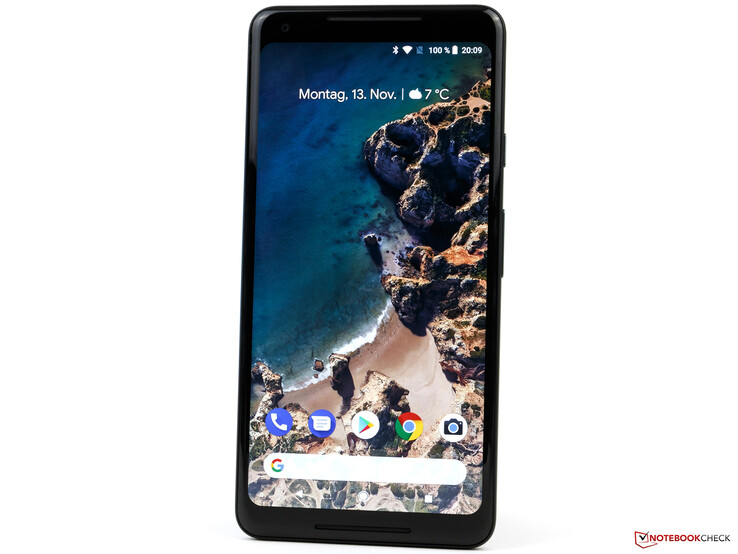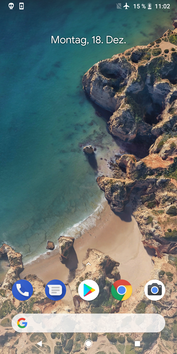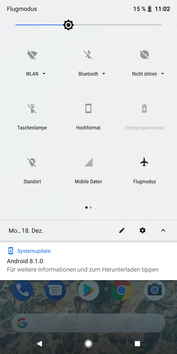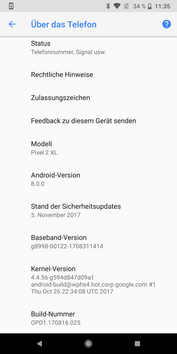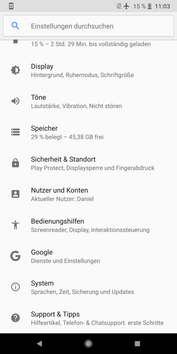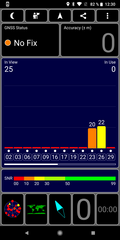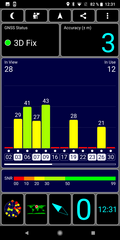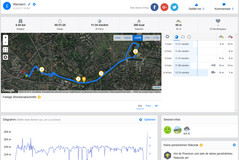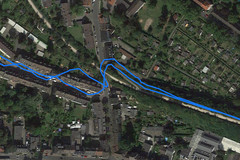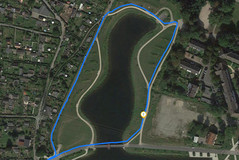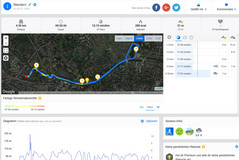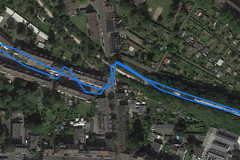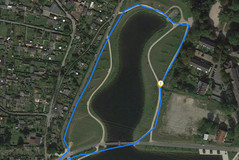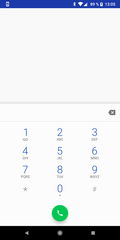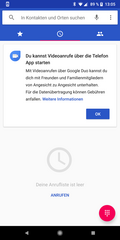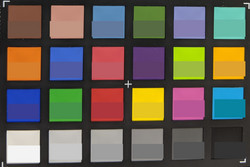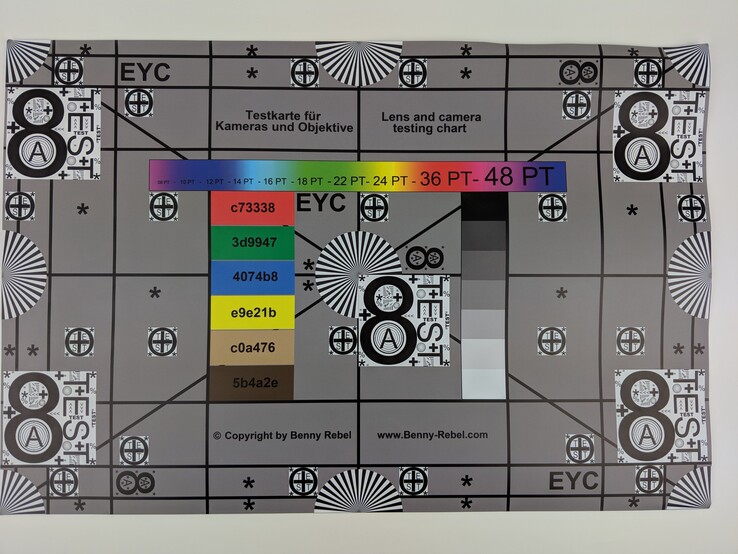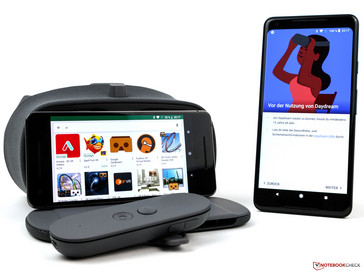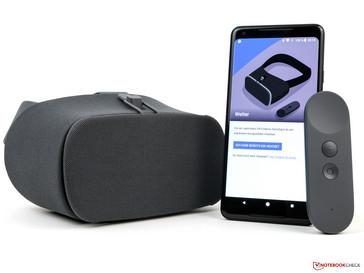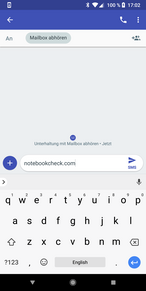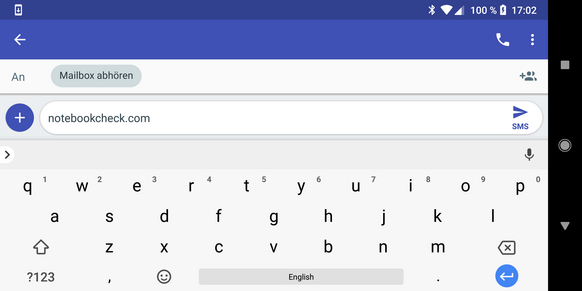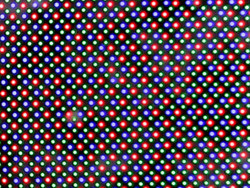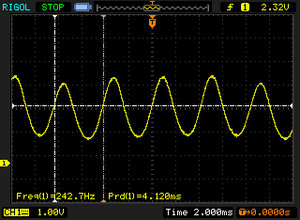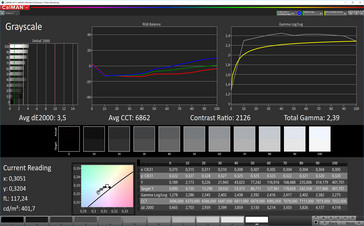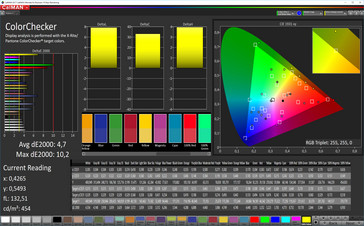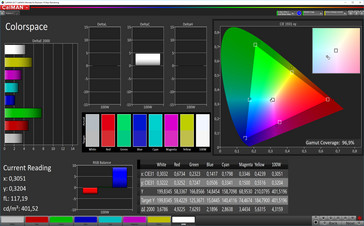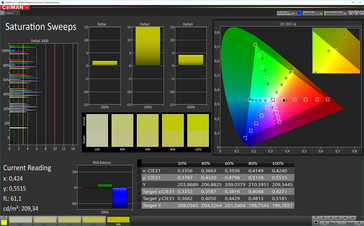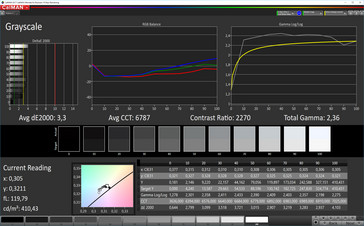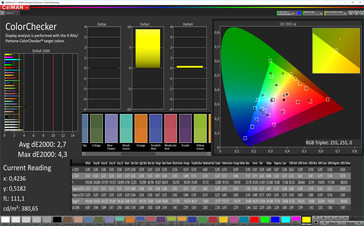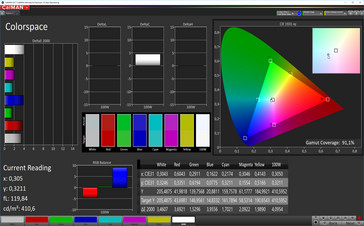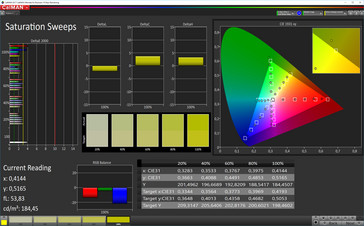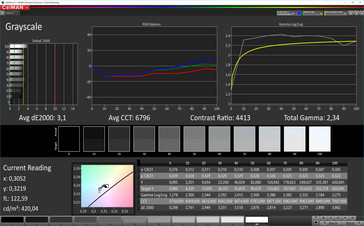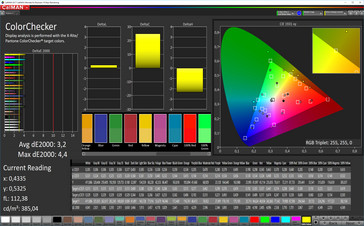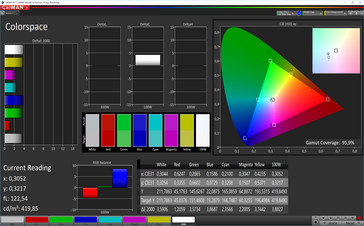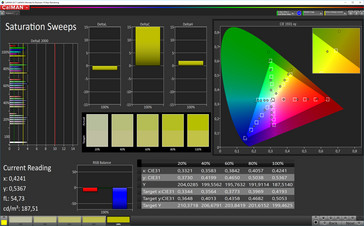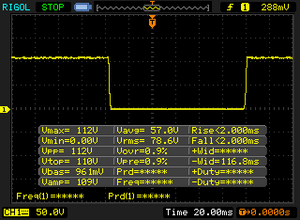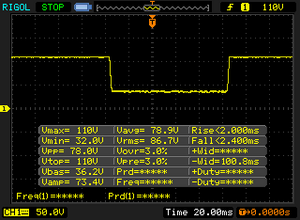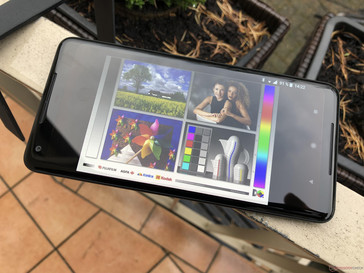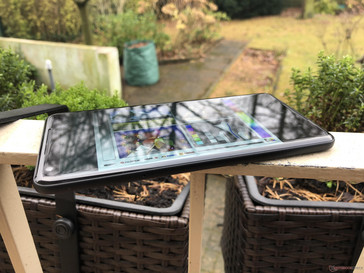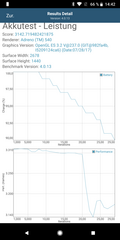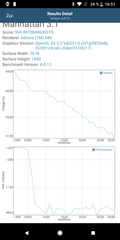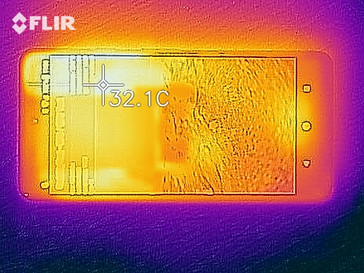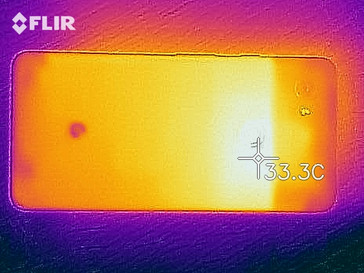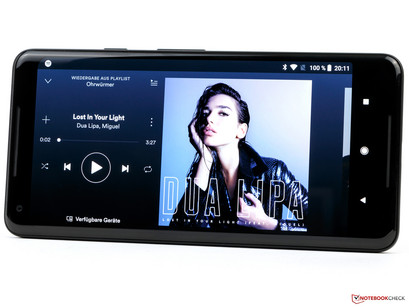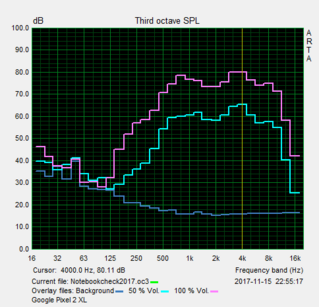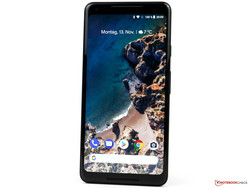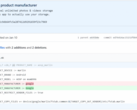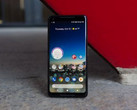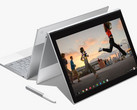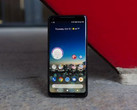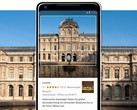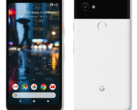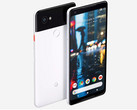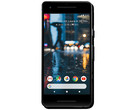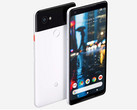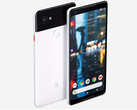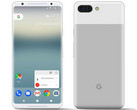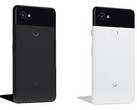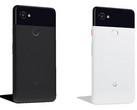Google Pixel 2 XL Smartphone Review
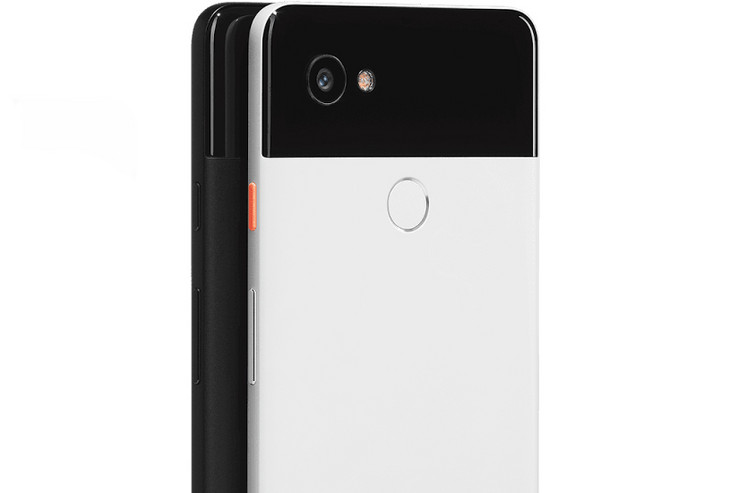
For the original German review, see here.
The Google Pixel 2 XL is visually very different than its smaller sibling and has a 6-inch (15.24 cm) POLED display in the 2:1 format with QHD+ resolution. Added to this are more storage in the base model, a new camera, and a fast Snapdragon 835. With ac-WLAN and LTE Cat. 15, the communication modules are also up-to-date. As in the previous year, Google continues to refrain from including any microSD card storage extension. The two front speakers, which are supposed to provide a better audio experience in landscape mode, are new. The 64-GB version of the Pixel 2 XL starts at 939 Euros (~$1117; $849 in the US). Anyone who prefers to have more storage has to pay a hefty 110 Euros (~$131) extra to double it. As with the predecessor, you can store any pictures and videos recorded with the Pixel in full resolution on Google Drive, but this is now only for a limited period of time. The only differences compared to the smaller Pixel 2 are really the display and battery, the basic technical equipment is the same.
Google's XL high-end smartphone has to face the gathered competition, which include the Samsung Galaxy Note 8, the Huawei P10 Plus, the Apple iPhone 8 Plus, the LG V30, the Sony Xperia XZ Premium, the HTC U11, and the OnePlus 5 among others.
Case
As with most other high-end competitors of 2017, the Google Pixel 2 XL also has particularly small bezels. The visual relation to the LG V30 cannot be denied. The case is made from an aluminum alloy, and only part of the back is covered by glass. The front is protected entirely by Corning Gorilla Glass 5.
The workmanship of the Google Pixel 2 XL is on a high level. It shows itself as very robust and cannot be twisted, and due to the OLED technology, pressure on the panel cannot lead to any wave formation. The gaps are very tight and exact. The aluminum feels good in the hands. The display-to-surface ratio is very good, even though the bezels are even smaller in the Galaxy Note 8.
The SIM slot is flush with the case and can accept a Nano-SIM card. Furthermore, the smartphone is protected against dust and water according to the IP67 standard, which means that it can be submersed in water up to 1.5 meters (~5 ft) deep for up to half an hour without getting damaged. Accordingly, the battery is built-in and cannot be changed by the user.
The Google Pixel 2 comes in completely black color and black and white. In the latter version, the power button is orange. We are already familiar with such color accents from the Huawei P10 Plus, and while it is a matter of taste, we really like it.
Connectivity
As a cable connection, the Google Pixel 2 XL has USB 3.1 (Gen. 1, Type-C). NFC and Bluetooth 5.0 are also on board. The latter also supports aptX and aptX HD for high-resolution music content.
Moreover, it is again possible to store all the pictures and videos in full resolution on Google Drive for free. There is no storage limitation for this until January 15, 2021. Thereafter, the offer is limited to high-quality pictures. According to Google, this is supposed to make the storage expansion via microSD card unnecessary, so there is no built-in slot.
There is also no infrared transmitter, no radio, and no ability to wirelessly charge the smartphone.
Software
The Google Pixel 2 XL is delivered with pure Android 8.0 Oreo and is supposed to get software and security updates until October 2020.
The smartphone also has the new Google Lens, which is initially limited to the Pixel 2 models and will later be also made available to other devices. With Lens, recorded pictures can be analyzed by Google, and in this way buildings, landscapes, artwork, books, and CD covers can be recognized and then Google can provide the corresponding information via Google Assistant. In addition, it can simply take mail addresses or phone numbers from a flyer.
In addition, the Pixel smartphone always listens in and shows the artist and title on the always-on display, when music is recognized. This function can be optionally deactivated. In general, Google Assistant is supposed to be integrated more into the world of the user and can also be started with a simple press of the smartphone, similar to how you can already do in the HTC U11.
The update to Android 8.1 Oreo has been available since December 5th 2017.
Communication and GPS
Mobile Internet connections on the Google Pixel 2 XL are established via LTE Cat. 15 and numerous bands are supported. The Huawei Mate 10 Pro is currently the best smartphone in this respect if you require even more coverage. We used the Pixel 2 in the mobile networks of O2 as well as Vodafone, and we did not encounter any issues.
The smartphone supports the IEEE 802.11 standards a/b/g/n/ac in 2.4 as well as 5.0 GHz mobile networks. We can determine decent transfer rates in combination with our reference router Linksys EA8500, but the manufacturer has done without the MIMO antenna technology this time, so the Pixel 2 XL is much slower than its predecessor. This is hard to understand when you consider the high price. The dampening in direct proximity to the access point fluctuates between -32 and -40 dBm (2.4 GHz) and is increased to -82 dBm (5.0 GHz) two storeys higher, but HD video streaming from YouTube was still smooth.
The specification sheet of the Google Pixel 2 XL lists support for the satellite networks GPS, GLONASS, BeiDou, and Galileo. The satellite fix at the basement window did not work, but we got a signal within a few seconds outdoors with an accuracy of down to 3 meters (~10 ft).
We had to perform our practical test by foot this time due to the bad weather, but we still compared the performance of the smartphone with the Garmin Edge 500. The overall deviation is surprisingly high at around 180 meters (~590 ft, and both devices are slightly off the actual track in the area with many houses. A closer look at the recorded data shows the Pixel 2XL does not locate the position as frequently as the professional device, so the accuracy drops. This is particularly noticeable around the lake, but there should not be any limitations in terms of everyday navigation purposes.
Telephone Functions and Voice Quality
Google's phone app has a simple structure and not many features. The Pixel 2 XL also supports Voice over LTE (VoLTE) or Voice over Wi-Fi (VoWifi), respectively, in general, but it requires support from the provider. This was not the case for O2 at the time of the review.
The voice quality is good when you hold the smartphone to your ear: The voice of the other person is clear and easy to understand, while the Pixel user is a bit too quiet and appears to be quite far away. This impression is even enhanced when the speaker is active, which introduces some echoes. The sound from the Pixel is more artificial and less clear as well, so the overall impression is just average. The noise suppression is pretty reliable.
Cameras
The cameras are identical on both new Pixel 2 phones. At the front we find an 8 MP shooter with fixed focus and electronic image stabilization. Its nominal aperture of f/2.4 is quite common for front-facing cameras, although its large pixel size of 1.4 µm promises decent light sensitivity; which we found to be accurate during our tests at the launch event. Fortunately, the Pixel 2 supports its portrait mode feature that applies a bokeh effect to the background for selfies as well. The images are actually pretty convincing, even though the Portrait is quickly at its limit if the contours are uneven. The pictures are comparatively detailed and sharp.
The phone’s main rear-facing camera is referred to by Google as the best smartphone camera ever. Its 12.2 MP sensor with f/1.8 aperture and 1.4 µm large pixels is supported by laser autofocus and dual-pixel phase detection. The latter not only results in blazingly fast focusing - in combination with Google’s own machine learning algorithm, it also means that portrait mode is supported despite the lack of a second camera. The results of the main camera are better for the portrait mode compared to the front camera. The daylight pictures generally capture many details with a decent dynamic range. The sharpness is on par with the Mate 10 Pro, while the iPhone X falls a bit behind. The Pixel 2 also performs well in low-light conditions and beats the two rivals noticeably; it performs even slightly better than the Galaxy Note 8. There is no criticism for the fast trigger speed, but the camera could include more features. You do not get a manual mode for the camera, and you cannot take RAW pictures either.
The video mode is also light in terms of features. Users can only choose between three resolutions (UltraHD, Full HD, HD), all the other settings are handled by the camera. You get an optical as well as electronic image stabilization in return, which ensures smooth camera pans in particular.
We had a closer look at the camera performance of the Google Pixel 2 XL under controlled lighting conditions. We check the color performance with the ColorChecker Passport. Many colors are over-saturated, only cyan and lilac are a bit pale. The field for the light skin color suffers from a slight red hue.
The picture of the Test chart supports our impression of the sharp and detailed pictures. There is not much fray at the dark letters on the dark background either, and the overall sharpness only takes a small hit towards the edges. All in all, the camera performance is very good.
Accessories, Warranty & Daydream View
Google ships the Pixel 2 XL with a two-year warranty, which cannot be extended. Please see our Guarantees, Return Policies & Warranties FAQ for country-specific information. The scope of delivery includes a so called Quick-Switch cable, which is supposed to make the smartphone switch easier, a modular power adapter (USB-C, 18W), a SIM tool as well as an audio adapter from USB to 3.5 mm stereo jack.
Google offers additional accessories for the smartphone on its website, especially covers, cables, and power adapters. We also received the current Google Daydream View (2017) for the review. As with all other VR headsets, it is important to put them directly in front of your eyes to avoid blurry areas. This works pretty well with the Daydream View after some practice, but you have to attach it firmly, otherwise it can easily move. The set-up is easy and the compact controller is comfortable to use. However, we would appreciate more content. The VR headset is not only compatible with the Pixel models, but also smartphones from other manufacturers. Google provides a list of compatible devices on its website.
Input Devices & Handling
The 6-inch touchscreen of the Google Pixel 2 XL recognizes up to ten inputs simultaneously. Inputs are also executed quickly and accurately. It is not surprising that Google uses its own GBoard keyboard layout, but you can also download and install any other layout from the Play Store.
The physical buttons for the volume as well as the power button are made of metal and sit firmly in the chassis. Travel is short and the pressure points crisp, but the tactile feel is unfortunately identical except for the different size.
The fingerprint scanner at the back unlocks the smartphone reliably, but moist fingers will affect the detection rate. The input surface does not support additional gestures.
Display
In the Google Pixel 2 XL, a 6-inch (15.24 cm) POLED display from LG is used. It has a 2:1 (18:9) format and with 2880x1440 pixels, it offers an even higher pixel density than the smaller Pixel 2 model. Compared to the Pixel XL (16:9, 83.39 cm²), the panel area is noticeably larger, reaching 92.9 cm².
The first impression was convincing. In steep viewing angles we did not notice any color veils and the colors did not appear too saturated. As expected, the contrast ratio was excellent. However, this display will also use pulse width modulation (PWM).
The polarized glass will be an advantage when using it outside, since it promises a very low degree of reflections. In the LG V30, which uses the same display type, we criticized the too frugal regulation of the brightness by the brightness sensor. We are curious whether Google does a better job.
You can easily notice the relationship with the panel of the LG V30 when you look at the measurements, which are almost identical. The maximum luminance is reached in the manual mode at 420 nits on average, and the brightness distribution is even at 87%. The brightness is increased to 562 nits in the center with an even distribution of bright and dark surfaces (APL 50). This sounds like a lot, but is not really overwhelming within the comparison group. Smartphones such as the Galaxy S8+ (up to 781 nits) or the Mate 10 Pro (up to 897 nits) manage even higher values with activated ambient light sensors.
The brightness of OLED panels is controlled via pulse-width modulation (PWM), and this is also the case for the Google Pixel 2 XL. The amplitude characteristic is flat, but there can quickly be eye strain or even headaches for sensitive users.
| |||||||||||||||||||||||||
Brightness Distribution: 87 %
Center on Battery: 415 cd/m²
Contrast: ∞:1 (Black: 0 cd/m²)
ΔE ColorChecker Calman: 2.7 | ∀{0.5-29.43 Ø4.78}
ΔE Greyscale Calman: 3.3 | ∀{0.09-98 Ø5}
Gamma: 2.36
CCT: 6787 K
| Google Pixel 2 XL P-OLED, 2880x1440, 6" | Google Pixel XL 2016 AMOLED, 2560x1440, 5.5" | LG V30 OLED, 2880x1440, 6" | Apple iPhone X Super AMOLED, 2436x1125, 5.8" | Huawei Mate 10 Pro OLED, 2160x1080, 6" | Samsung Galaxy S8 Plus Super AMOLED, 2960x1440, 6.2" | OnePlus 5T AMOLED, 2160x1080, 6" | |
|---|---|---|---|---|---|---|---|
| Screen | -31% | -35% | 39% | 32% | 31% | 13% | |
| Brightness middle (cd/m²) | 415 | 402 -3% | 432 4% | 600 45% | 629 52% | 560 35% | 425 2% |
| Brightness (cd/m²) | 420 | 408 -3% | 428 2% | 606 44% | 636 51% | 562 34% | 423 1% |
| Brightness Distribution (%) | 87 | 85 -2% | 87 0% | 94 8% | 94 8% | 93 7% | 92 6% |
| Black Level * (cd/m²) | |||||||
| Colorchecker dE 2000 * | 2.7 | 4 -48% | 4.18 -55% | 1.2 56% | 1.7 37% | 1.7 37% | 2.1 22% |
| Colorchecker dE 2000 max. * | 4.3 | 10.1 -135% | 8.53 -98% | 3 30% | 3.6 16% | 3.4 21% | 3.4 21% |
| Greyscale dE 2000 * | 3.3 | 3.2 3% | 5.3 -61% | 1.6 52% | 2.4 27% | 1.6 52% | 2.5 24% |
| Gamma | 2.36 93% | 2.19 100% | 2.33 94% | 2.23 99% | 2.15 102% | 2.13 103% | 2.32 95% |
| CCT | 6787 96% | 7037 92% | 7487 87% | 6707 97% | 6337 103% | 6435 101% | 6455 101% |
| Color Space (Percent of AdobeRGB 1998) (%) | 81.57 | ||||||
| Color Space (Percent of sRGB) (%) | 99.87 |
* ... smaller is better
Screen Flickering / PWM (Pulse-Width Modulation)
| Screen flickering / PWM detected | 242.7 Hz | ||
The display backlight flickers at 242.7 Hz (worst case, e.g., utilizing PWM) . The frequency of 242.7 Hz is relatively low, so sensitive users will likely notice flickering and experience eyestrain at the stated brightness setting and below. In comparison: 53 % of all tested devices do not use PWM to dim the display. If PWM was detected, an average of 8118 (minimum: 5 - maximum: 343500) Hz was measured. | |||
We check the picture quality of the POLED display in the Google Pixel XL 2 with the spectrophotometer and the professional software CalMAN. Google's calibration is better than LG's on the V30. The Pixel smartphone features three different picture profiles. The default mode Saturated offers the widest color gamut. Contrary to the statement during the launch, DCI-P3 is not covered completely, but the panel is closer to AdobeRGB with a slightly enhanced gamut for red. The Natural mode offers the most natural color presentation.
The grayscale performance is pretty similar in all three modes. Deviations are usually not visible with the naked eye, but the Google Pixel 2 XL does not provide very wide viewing angles (more on that later). The color accuracy is the lowest in the Natural mode at an average DeltaE of 2.7, which is basically invisible to the human eye. Some individual colors exceed the DeltaE mark of 3; we record the highest deviation for autumnal green (foliage) at 4.3.
Display Response Times
| ↔ Response Time Black to White | ||
|---|---|---|
| 4 ms ... rise ↗ and fall ↘ combined | ↗ 2 ms rise | |
| ↘ 2 ms fall | ||
| The screen shows very fast response rates in our tests and should be very well suited for fast-paced gaming. In comparison, all tested devices range from 0.1 (minimum) to 240 (maximum) ms. » 15 % of all devices are better. This means that the measured response time is better than the average of all tested devices (20.2 ms). | ||
| ↔ Response Time 50% Grey to 80% Grey | ||
| 4.4 ms ... rise ↗ and fall ↘ combined | ↗ 2 ms rise | |
| ↘ 2.4 ms fall | ||
| The screen shows very fast response rates in our tests and should be very well suited for fast-paced gaming. In comparison, all tested devices range from 0.165 (minimum) to 636 (maximum) ms. » 15 % of all devices are better. This means that the measured response time is better than the average of all tested devices (31.6 ms). | ||
The Google Pixel 2 XL benefits from its high contrast ratio outdoors and the luminance is usually sufficient for most situations. However, the panel will reach its limitations in bright environments and especially under direct sunlight. Some competitors perform much better in this respect thanks to brighter panels.
You expect wide viewing angles from every direction from an OLED panel. However, the POLED screen in the Google Pixel 2 XL cannot completely meet this requirement. There are no color inversions, but you can quickly see a color cast even with slight shifts of the viewing angle. The color therefore always appears to be a bit distorted, which is particularly annoying on contents with large white surfaces.
Performance
In the Google Pixel 2 XL, the current high-end SoC from Qualcomm is used: the Snapdragon 835. It is accompanied by 4 GB of LPDDR4x RAM memory. The smartphone is available with 64 or 128 GB of internal storage. The graphics calculations are performed by the Qualcomm Adreno 540.
The test model is particularly impressive in the system benchmarks and just beats the Huawei Mate 10 Pro as well as the HTC U11. The vanilla Android solution has a positive effect and ensures a very fast system launch (just seven seconds) since version 8.1 Oreo. The CPU performance is on the expected level, just like the results in the GPU benchmarks. There are no major outliers and the test model is only clearly beaten by the iPhone in some tests.
| AnTuTu v6 - Total Score (sort by value) | |
| Google Pixel 2 XL | |
| Google Pixel XL 2016 | |
| Samsung Galaxy Note 8 | |
| HTC U11 | |
| OnePlus 5T | |
| Sony Xperia XZ Premium | |
| LG V30 | |
| Huawei Mate 10 Pro | |
| Apple iPhone X | |
| PCMark for Android | |
| Work performance score (sort by value) | |
| Google Pixel 2 XL | |
| Google Pixel XL 2016 | |
| Samsung Galaxy Note 8 | |
| HTC U11 | |
| OnePlus 5T | |
| Sony Xperia XZ Premium | |
| LG V30 | |
| Huawei Mate 10 Pro | |
| Work 2.0 performance score (sort by value) | |
| Google Pixel 2 XL | |
| Samsung Galaxy Note 8 | |
| HTC U11 | |
| OnePlus 5T | |
| Sony Xperia XZ Premium | |
| LG V30 | |
| Huawei Mate 10 Pro | |
| GFXBench 3.0 | |
| on screen Manhattan Onscreen OGL (sort by value) | |
| Google Pixel 2 XL | |
| Google Pixel XL 2016 | |
| Samsung Galaxy Note 8 | |
| HTC U11 | |
| OnePlus 5T | |
| Sony Xperia XZ Premium | |
| LG V30 | |
| Huawei Mate 10 Pro | |
| Apple iPhone X | |
| 1920x1080 1080p Manhattan Offscreen (sort by value) | |
| Google Pixel 2 XL | |
| Google Pixel XL 2016 | |
| Samsung Galaxy Note 8 | |
| HTC U11 | |
| OnePlus 5T | |
| Sony Xperia XZ Premium | |
| LG V30 | |
| Huawei Mate 10 Pro | |
| Apple iPhone X | |
| GFXBench 3.1 | |
| on screen Manhattan ES 3.1 Onscreen (sort by value) | |
| Google Pixel 2 XL | |
| Google Pixel XL 2016 | |
| Samsung Galaxy Note 8 | |
| HTC U11 | |
| OnePlus 5T | |
| Sony Xperia XZ Premium | |
| LG V30 | |
| Huawei Mate 10 Pro | |
| Apple iPhone X | |
| 1920x1080 Manhattan ES 3.1 Offscreen (sort by value) | |
| Google Pixel 2 XL | |
| Google Pixel XL 2016 | |
| Samsung Galaxy Note 8 | |
| HTC U11 | |
| OnePlus 5T | |
| Sony Xperia XZ Premium | |
| LG V30 | |
| Huawei Mate 10 Pro | |
| Apple iPhone X | |
| Lightmark - 1920x1080 1080p (sort by value) | |
| Google Pixel 2 XL | |
| Samsung Galaxy Note 8 | |
| HTC U11 | |
| Huawei Mate 10 Pro | |
| Basemark X 1.1 | |
| Medium Quality (sort by value) | |
| Google Pixel XL 2016 | |
| Samsung Galaxy Note 8 | |
| HTC U11 | |
| Huawei Mate 10 Pro | |
| High Quality (sort by value) | |
| Google Pixel XL 2016 | |
| Samsung Galaxy Note 8 | |
| HTC U11 | |
| Huawei Mate 10 Pro | |
| Basemark ES 3.1 / Metal - offscreen Overall Score (sort by value) | |
| Google Pixel 2 XL | |
| Google Pixel XL 2016 | |
| Samsung Galaxy Note 8 | |
| HTC U11 | |
| Huawei Mate 10 Pro | |
| Apple iPhone X | |
| Epic Citadel - Ultra High Quality (sort by value) | |
| Google Pixel XL 2016 | |
| Samsung Galaxy Note 8 | |
| HTC U11 | |
| Huawei Mate 10 Pro | |
Web browsing is a smooth experience on the Google Pixel 2 XL and even complex websites are quickly loaded. The benchmark results are also good and the test model is always in the upper third of the comparison chart, only the Mozilla Kraken score is comparatively low.
| JetStream 1.1 - Total Score | |
| Apple iPhone X (IOS 11.1.1) | |
| HTC U11 (Chrome 58) | |
| OnePlus 5T (Chrome 63) | |
| Google Pixel 2 XL (Chrome 62) | |
| Samsung Galaxy S8 Plus (Samsung Browser 5.2) | |
| Sony Xperia XZ Premium (Chrome 59) | |
| Huawei Mate 10 Pro (Chrome 61) | |
| Google Pixel XL 2016 (Chrome 53) | |
| LG V30 (Chrome 62) | |
| Octane V2 - Total Score | |
| Apple iPhone X (IOS 11.1.2) | |
| Samsung Galaxy S8 Plus (Samsung Browser 5.2) | |
| OnePlus 5T (Chrome 63) | |
| HTC U11 (Chrome 58) | |
| Google Pixel 2 XL (Chrome 62) | |
| Sony Xperia XZ Premium (Chrome 59) | |
| LG V30 (Chrome 62) | |
| Huawei Mate 10 Pro (Chrome 61) | |
| Google Pixel XL 2016 (Chrome 53) | |
| Mozilla Kraken 1.1 - Total | |
| LG V30 (Chrome 62) | |
| Huawei Mate 10 Pro (Chrome 61) | |
| Google Pixel 2 XL (Chrome 62) | |
| Sony Xperia XZ Premium (Chrome 59) | |
| OnePlus 5T (Chrome 63) | |
| HTC U11 (Chrome 58) | |
| Google Pixel XL 2016 (Chrome 53) | |
| Samsung Galaxy S8 Plus (Samsung Browser 5.2) | |
| Apple iPhone X (IOS 11.1.2) | |
| WebXPRT 2015 - Overall | |
| Apple iPhone X (Safari Mobile 11.0) | |
| Google Pixel 2 XL (Chrome 62) | |
| OnePlus 5T (Chrome 63) | |
| HTC U11 (Chrome 58) | |
| Huawei Mate 10 Pro (Chrome 61) | |
| Samsung Galaxy S8 Plus (Samsung Browser 5.2) | |
| Sony Xperia XZ Premium (Chrome 59) | |
| LG V30 (Chrome 62) | |
| Google Pixel XL 2016 (Chrome 53) | |
* ... smaller is better
The Google Pixel XL was still equipped with eMMC storage, while the Google's Pixel 2 is shipped with modern UFS 2.1 storage. All the benchmark results are very good, only the writing performance of small data blocks is not so great. The Mate 10 Pro in particular is better in this respect.
You can either get a 64 or 128 GB version of the Google Pixel 2 XL. After the initial launch of our 64 GB model, we still had about 54 GB at our disposal. As with the previous model, you get unlimited storage for your own pictures and videos in Google's cloud. However, this service is a bit limited by now and only allows the storage of original quality pictures until January 15th 2021. All pictures will be limited to "high quality" after this date.
| Google Pixel 2 XL | Google Pixel XL 2016 | LG V30 | Sony Xperia XZ Premium | Samsung Galaxy Note 8 | Huawei Mate 10 Pro | HTC U11 | |
|---|---|---|---|---|---|---|---|
| AndroBench 3-5 | -48% | -28% | -18% | -9% | 201% | 76% | |
| Sequential Read 256KB (MB/s) | 760 | 258.2 -66% | 669 -12% | 687 -10% | 797 5% | 732 -4% | 717 -6% |
| Sequential Write 256KB (MB/s) | 195.3 | 83.4 -57% | 193.2 -1% | 194 -1% | 205.9 5% | 208.7 7% | 206.4 6% |
| Random Read 4KB (MB/s) | 170.6 | 87.7 -49% | 78.2 -54% | 74.1 -57% | 122.5 -28% | 132.3 -22% | 91.4 -46% |
| Random Write 4KB (MB/s) | 17.84 | 14.56 -18% | 10.21 -43% | 17.2 -4% | 14.55 -18% | 164.4 822% | 80 348% |
| Sequential Read 256KB SDCard (MB/s) | 62.8 | 36.79 ? | 67.9 ? | 68.8 ? | |||
| Sequential Write 256KB SDCard (MB/s) | 47.2 | 33.31 ? | 59.3 ? | 46.25 ? |
Games
The graphics unit Adreno 540 in the Google Pixel 2 is very fast and supports all modern graphics APIs. All titles from the Play Store run smoothly at the highest quality settings, which is supported by our benchmarks.
The two front-facing speakers are well positioned, but you can easily cover them with the hands in landscape mode. Both the sensors as well as the touchscreen are very precise and does not give any cause any criticism.
| Asphalt 8: Airborne | |||
| Settings | Value | ||
| high | 30 fps | ||
| very low | 30 fps | ||
| Dead Trigger 2 | |||
| Settings | Value | ||
| high | 59 fps | ||
Emissions
Temperature
The surface temperatures of the Google Pixel 2 XL are very low and not critical at all, even under load.
The situation is a bit different under the hood during the GFXBench battery tests. The T-Rex test, which uses the graphics API OpenGL ES 2.0, shows a steady performance for quite a while, and there is only a small drop (not even up to 6%) after the 20th run. The Manhattan test, which is more challenging for the SoC, results in a bigger performance drop. We can see a deficit of up to 20% after just five runs. However, the limitation should not be noticeable during everyday tasks.
(+) The maximum temperature on the upper side is 33.3 °C / 92 F, compared to the average of 35.2 °C / 95 F, ranging from 21.9 to 247 °C for the class Smartphone.
(+) The bottom heats up to a maximum of 34.2 °C / 94 F, compared to the average of 34 °C / 93 F
(+) In idle usage, the average temperature for the upper side is 27.6 °C / 82 F, compared to the device average of 32.9 °C / 91 F.
Speakers
The Google Pixel 2 XL is equipped with two front-facing speakers. They are not just really loud at up to 88 dB(A), but they also sound comparatively good. Only the slight drop in the range around 2 kHz is a bit unfortunate. The smartphone cannot produce any bass, but the lower mids are well represented and create at least a somewhat powerful sound.
The Pixel 2 XL performs well for a smartphone, but there is unfortunately no stereo jack, so you either need USB-C headphones or the provided adapter for wired headphones. A pair of Bluetooth headphones is the better solution because the Pixel models support aptX HD.
Google Pixel 2 XL audio analysis
(+) | speakers can play relatively loud (88.4 dB)
Bass 100 - 315 Hz
(-) | nearly no bass - on average 28.1% lower than median
(±) | linearity of bass is average (9.5% delta to prev. frequency)
Mids 400 - 2000 Hz
(+) | balanced mids - only 3.2% away from median
(+) | mids are linear (5.5% delta to prev. frequency)
Highs 2 - 16 kHz
(+) | balanced highs - only 3.1% away from median
(+) | highs are linear (4.2% delta to prev. frequency)
Overall 100 - 16.000 Hz
(±) | linearity of overall sound is average (19.6% difference to median)
Compared to same class
» 29% of all tested devices in this class were better, 8% similar, 63% worse
» The best had a delta of 11%, average was 35%, worst was 134%
Compared to all devices tested
» 48% of all tested devices were better, 7% similar, 45% worse
» The best had a delta of 4%, average was 24%, worst was 134%
HTC U11 audio analysis
(±) | speaker loudness is average but good (81.4 dB)
Bass 100 - 315 Hz
(-) | nearly no bass - on average 24.5% lower than median
(±) | linearity of bass is average (13.3% delta to prev. frequency)
Mids 400 - 2000 Hz
(+) | balanced mids - only 4.1% away from median
(±) | linearity of mids is average (7.4% delta to prev. frequency)
Highs 2 - 16 kHz
(±) | higher highs - on average 5.1% higher than median
(+) | highs are linear (6.2% delta to prev. frequency)
Overall 100 - 16.000 Hz
(±) | linearity of overall sound is average (22.1% difference to median)
Compared to same class
» 46% of all tested devices in this class were better, 7% similar, 47% worse
» The best had a delta of 11%, average was 35%, worst was 134%
Compared to all devices tested
» 63% of all tested devices were better, 6% similar, 31% worse
» The best had a delta of 4%, average was 24%, worst was 134%
Huawei Mate 10 Pro audio analysis
(+) | speakers can play relatively loud (84.4 dB)
Bass 100 - 315 Hz
(-) | nearly no bass - on average 28.1% lower than median
(±) | linearity of bass is average (10.6% delta to prev. frequency)
Mids 400 - 2000 Hz
(±) | reduced mids - on average 7.4% lower than median
(±) | linearity of mids is average (9.2% delta to prev. frequency)
Highs 2 - 16 kHz
(±) | higher highs - on average 7% higher than median
(+) | highs are linear (3% delta to prev. frequency)
Overall 100 - 16.000 Hz
(±) | linearity of overall sound is average (25.9% difference to median)
Compared to same class
» 65% of all tested devices in this class were better, 6% similar, 29% worse
» The best had a delta of 11%, average was 35%, worst was 134%
Compared to all devices tested
» 79% of all tested devices were better, 4% similar, 17% worse
» The best had a delta of 4%, average was 24%, worst was 134%
Frequency Comparison (Checkboxes select/deselectable!)
Battery Runtime
Power Consumption
The Google Pixel 2 XL has a slightly larger battery capacity at 3520 mAh compared to the previous model (3450 mAh). We are rather surprised by the high idle consumption, because the smartphone pulls more than 1W from the socket even at the lowest brightness setting.
The charging time of the Pixel 2 XL, which supports QuickCharge, was 152 minutes running Android 8.0. However, it takes more than four hours after the update to Android 8.1. We believe this will be fixed with an update soon. Unfortunately, the smartphone does not support wireless charging.
| Off / Standby | |
| Idle | |
| Load |
|
Key:
min: | |
| Google Pixel 2 XL 3520 mAh | Google Pixel XL 2016 3450 mAh | LG V30 3300 mAh | OnePlus 5T 3300 mAh | Huawei Mate 10 Pro 4000 mAh | Samsung Galaxy S8 Plus 3500 mAh | Apple iPhone X 2716 mAh | |
|---|---|---|---|---|---|---|---|
| Power Consumption | 24% | 21% | 21% | 19% | 27% | -1% | |
| Idle Minimum * (Watt) | 1.28 | 0.53 59% | 0.72 44% | 0.58 55% | 0.85 34% | 0.68 47% | 1.03 20% |
| Idle Average * (Watt) | 1.87 | 1.07 43% | 1.37 27% | 1.44 23% | 1.15 39% | 1.13 40% | 2.4 -28% |
| Idle Maximum * (Watt) | 1.89 | 1.12 41% | 1.41 25% | 1.53 19% | 1.23 35% | 1.16 39% | 2.6 -38% |
| Load Average * (Watt) | 3.73 | 5.53 -48% | 3.46 7% | 3.17 15% | 4.12 -10% | 4.69 -26% | 2.96 21% |
| Load Maximum * (Watt) | 8.08 | 6.26 23% | 7.83 3% | 8.54 -6% | 8.42 -4% | 5.24 35% | 6.6 18% |
* ... smaller is better
Battery Runtime
The battery runtime is decent, despite the increased power consumption, and should easily last a normal day. However, the competition lasts even longer, and sometimes with smaller batteries.
We also had the chance to test the Google Pixel 2 XL with both Oreo versions. We compared the results of our WLAN test at an adjusted luminance of 150 nits. The Pixel 2 XL actually loses a few minutes with the latest Android 8.1 Oreo and only lasts about nine hours.
Once the battery runs low, you can activate the power-save mode (manually or automatically), which will limit the functionality of the smartphone to the essentials.
| Google Pixel 2 XL 3520 mAh | Google Pixel XL 2016 3450 mAh | LG V30 3300 mAh | Huawei Mate 10 Pro 4000 mAh | Samsung Galaxy S8 Plus 3500 mAh | Apple iPhone X 2716 mAh | Sony Xperia XZ Premium 3230 mAh | |
|---|---|---|---|---|---|---|---|
| Battery runtime | -21% | 14% | 28% | 6% | -18% | 5% | |
| Reader / Idle (h) | 28.4 | 22.2 -22% | 31.9 12% | 29.1 2% | 26.1 -8% | 21.5 -24% | 29.2 3% |
| H.264 (h) | 11.2 | 8.4 -25% | 13.7 22% | 15.5 38% | 12.4 11% | 10.6 -5% | 13.4 20% |
| WiFi v1.3 (h) | 9.7 | 8.4 -13% | 12.9 33% | 13.6 40% | 12.3 27% | 9.4 -3% | 11.6 20% |
| Load (h) | 5 | 3.8 -24% | 4.5 -10% | 6.6 32% | 4.6 -8% | 3 -40% | 3.9 -22% |
| PCMark for Android - Work 2.0 battery life | |
| Huawei Mate 10 Pro | |
| Google Pixel 2 XL | |
| Samsung Galaxy S8 Plus | |
| Samsung Galaxy Note 8 | |
| HTC U11 | |
Pros
Cons
Verdict
Google’s focus and the main selling point of its latest smartphones is the combination of hardware, software, and artificial intelligence that these two constitute. The Google Pixel 2 XL is certainly a very good smartphone, but there is still quite a lot to criticize, especially at the high price point.
The biggest drawback of the smartphone is the display. Our measurements are performed from a vertical position onto the display, so the results are actually really good. However, even small shifts of the viewing angle will result in a visible color cast, so the picture always looked a bit distorted. Furthermore, the POLED screen is also too dark among the high-end competition, which is especially problematic under direct sunlight. We cannot understand why Google opted to remove the MIMO-WLAN technology, either.
The Google Pixel 2 XL is a great smartphone, but the display is a serious drawback.
One of the highlights is the camera of the Pixel 2 XL, which leaves a great impression in all lighting conditions and Google Lens is a great additional feature. The rating is a bit lower due to the missing Pro mode and the lack of video features, but we think the pure picture quality of the Pixel 2 XL is even slightly ahead of Samsung's Galaxy S8 models.
The long update cycle (until October 2020) of the new Pixel models is another major advantage. If you plan on using the device for a long time and want a smartphone with a modern OS, the Pixel 2 XL is hard to ignore.
Google Pixel 2 XL
- 12/20/2017 v6 (old)
Daniel Schmidt




